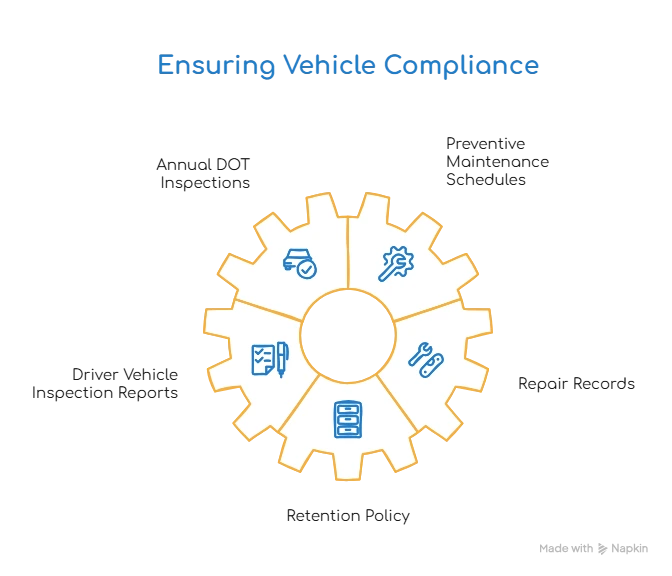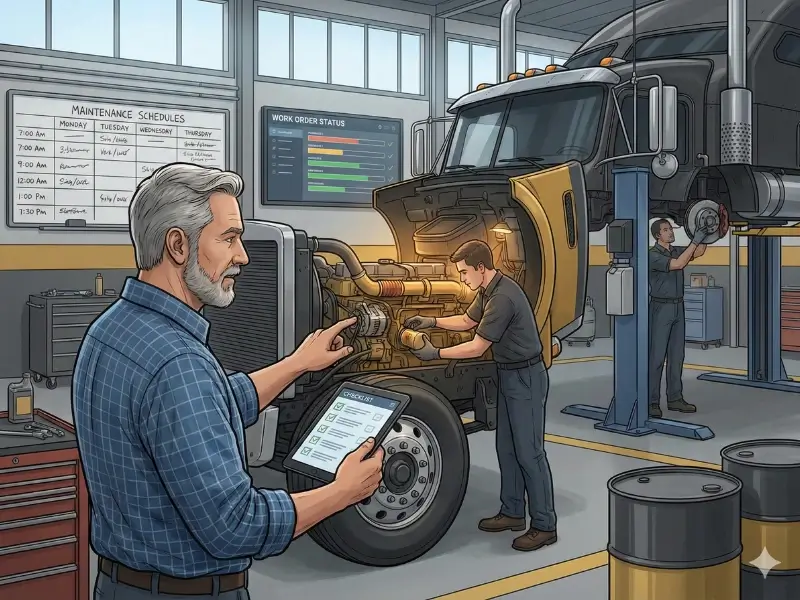Key Takeaways
A DOT safety audit reviews your fleet’s compliance with FMCSA regulations across insurance, driver files, hours of service, vehicle maintenance, drug & alcohol testing, accidents, and hazmat. To pass confidently in 2025:
- Keep a centralized DOT compliance checklist with all required records.
- Monitor CSA scores and address violations early.
- Train drivers on HOS, DVIRs, and compliance basics.
- Use ELDs, maintenance software, and DOT compliance software for organized records.
- Run mock audits to spot gaps before FMCSA does.
Running a fleet means living with audits. A DOT safety audit can feel intimidating, but it doesn’t have to derail operations. With the right systems, training, and technology, you can turn DOT audit preparation into a routine that supports safer drivers, healthier vehicles, and fewer surprises.
This guide explains how to pass a DOT audit, outlines DOT audit requirements 2025, and gives you a practical DOT compliance checklist you can use today.
What is a DOT Audit and Why Does It Matters?
A DOT audit is an FMCSA review that verifies your company’s compliance with FMCSA safety regulations. Audits are triggered by poor CSA scores, complaints, crash history, or sometimes at random. Ratings matter:
- Satisfactory: You’re in good standing.
- Conditional: Expect higher insurance and fewer loads.
- Unsatisfactory: Operations may be shut down until corrected.
For many carriers, the fastest path to a “Satisfactory” is building FMCSA compliance into everyday operations, not scrambling when the auditor calls.
Types of DOT Audits
DOT Audit Requirements 2025: What Auditors Look For
Auditors typically review six core areas. Use these as your blueprint.
General Compliance & Insurance
- Maintain proof of financial responsibility (MCS-90).
- Minimum liability for most non-hazmat freight remains $750,000; hazmat can require more-up to $5 million.
- Keep your MCS-150 updated every 24 months.
These are the foundational DOT audit requirements 2025 that you should verify quarterly.
Driver Qualification Files (DQFs)
DQFs are often the most time-consuming area. Ensure your driver qualification files DOT documentation includes:
- Valid CDL and required endorsements
- Current Medical Examiner’s Certificate
- Initial application with previous employer checks
- Annual MVRs and safety performance history
- Road test certificate or equivalent
If you’re short on admin support, DOT compliance software can centralize DQFs and automate reminders for expirations.
Hours of Service (HOS)
Hours of service violations DOT audit findings are among the top reasons carriers get flagged. FMCSA requires ELDs for most carriers:
- Keep six months of RODS available.
- Maintain supporting documents (fuel, tolls, BOLs).
- Provide ELD user manuals and driver instructions.
- Document HOS training and coaching.
Vehicle Maintenance
Your vehicles must meet vehicle maintenance DOT requirements with records to prove it:
- Annual DOT inspections
- Preventive maintenance schedules
- Driver Vehicle Inspection Reports (DVIRs) for the last 90 days
- Repair records (brakes, tires, lights, safety equipment)
- Retention: 1 year while active and 6 months after decommissioning

Drug & Alcohol Testing
Your program must meet DOT drug and alcohol testing compliance rules:
- Written policy acknowledging DOT standards
- Pre-employment negatives on file before safety-sensitive work
- Random testing program with scientifically valid selection
- Annual MIS summary (if required)
- FMCSA Clearinghouse queries (pre-employment and annual)
- Supervisor reasonable-suspicion training records
Accident Register
Maintain a three-year accident register with police reports, driver statements, and post-accident tests when required. This is also essential for any fleet compliance audit if you pursue insurance reductions or third-party safety certifications.
DOT Compliance for Small Fleets
Smaller carriers often assume audits target big fleets. Not true. DOT compliance for small fleets is identical in scope-only the scale differs. If you’re an owner-operator or running a handful of trucks:
- Use a simple digital system for DQFs, HOS, and maintenance.
- Calendar recurring compliance tasks (MVR pulls, MEC renewals, training refreshers).
- Consider a quarterly self-audit using this guide to stay ahead.
The DOT Compliance Checklist
DOT compliance checklist you can deploy today:
Company & Insurance
- MCS-90 on file and accurate
- Active policy meets minimum liability levels
- MCS-150 updated within 24 months
Driver Files
- CDL + endorsements verified and current
- MEC on file; no lapsed medicals
- Initial application with employer checks
- Annual MVR and safety performance review
- Road test certificate/equivalent
HOS / ELD
- 6 months of RODS ready for export
- Supporting docs mapped to logs
- ELD manuals + malfunction procedures in cabs
- Driver HOS/ELD training records
Vehicle Maintenance
- Annual DOT inspection reports
- PM schedules aligned to OEM or risk profile
- DVIRs for last 90 days (defects repaired and signed off)
- Repair records (brakes, tires, lights, safety items)
- Retention policy (1 year active, 6 months post-service)
Drug & Alcohol
- Written policy and distribution proof
- Pre-employment and random results on file
- Random selection methodology documented
- Clearinghouse pre-hire + annual queries
- MIS summary (if applicable)
- Supervisor reasonable-suspicion training
Accidents
- 3-year accident register
- Police reports, driver statements, post-accident tests
Hazmat (if applicable)
- Training certificates current
- Security plan maintained and tested
Common DOT Audit Failure Reasons and How to Avoid Them
Avoid these DOT audit failure reasons at all costs:
- Insufficient insurance or expired MCS-90
- Using a driver with an invalid CDL or expired MEC
- Operating a CMV that’s been placed out of service
- Missing random tests or no verifiable selection process
- HOS falsification patterns or systematic ELD misuse
- No proof of required training (HOS, reasonable suspicion, hazmat)
Pro tips to stay clean:
- Review CSA scores monthly and coach trends.
- Use ELD analytics to pinpoint unassigned drive time and edits.
- Tie DVIR defects to completed work orders-close the loop.
- Audit the random pool size and selection cadence every quarter.
Technology That Makes Passing Easier
Modern tools reduce admin workload and strengthen your audit trail:
- DOT compliance software to centralize policies, training, DQFs, and retention schedules
- ELD platforms that surface HOS risk, automate RODS retention, and simplify auditor exports
- Maintenance systems that link DVIRs to repair orders and enforce PM intervals
- Driver apps for streamlined DVIRs, document capture, and policy acknowledgments
If you’re evaluating systems, prioritize audit-ready exports (RODS, DVIRs, DQFs), built-in retention rules, and role-based access.
A Simple, Repeatable DOT Audit Preparation Rhythm
Make compliance a lifestyle, not a fire drill:
- Monthly: Check CSA score alerts, coach top HOS issues, spot-check DQFs and maintenance closures.
- Quarterly: Perform a mini fleet compliance audit-sample 10–20% of files across drivers and vehicles.
- Semi-Annual: Full mock audit against this checklist; document corrective actions.
- Annual: Refresh HOS and reasonable-suspicion training; re-validate random testing methodology; review your hazmat security plan (if applicable).
After the Audit: If You Need to Recover
Didn’t get the rating you hoped for? You can still move forward:
- Submit a corrective action plan and request an upgrade.
- Negotiate civil penalties with documented fixes and timelines.
- Build a Safety Management Plan that aligns controls to each violation area.
- Keep communicating with your FMCSA contact-fast, complete responses build goodwill.
Bottom Line: How to Pass a DOT Audit
You pass by doing the basics brilliantly- every day. Keep insurance and filings current, maintain airtight driver qualification files DOT records, eliminate hours of service violations DOT audit triggers with training and ELD analytics, meet vehicle maintenance DOT requirements with disciplined PM and DVIR closures, and run a documented DOT drug and alcohol testing compliance program.
Stay audit-ready with Simply Fleet. Our fleet management software helps you centralize driver qualification files, track HOS logs, schedule preventive maintenance, and stay on top of DOT compliance. Don’t wait for an FMCSA knock. Make compliance a daily habit. Partner with Simply Fleet today and pass your next DOT safety audit with confidence.



.png)








.png)


.png)


.webp)
.webp)





